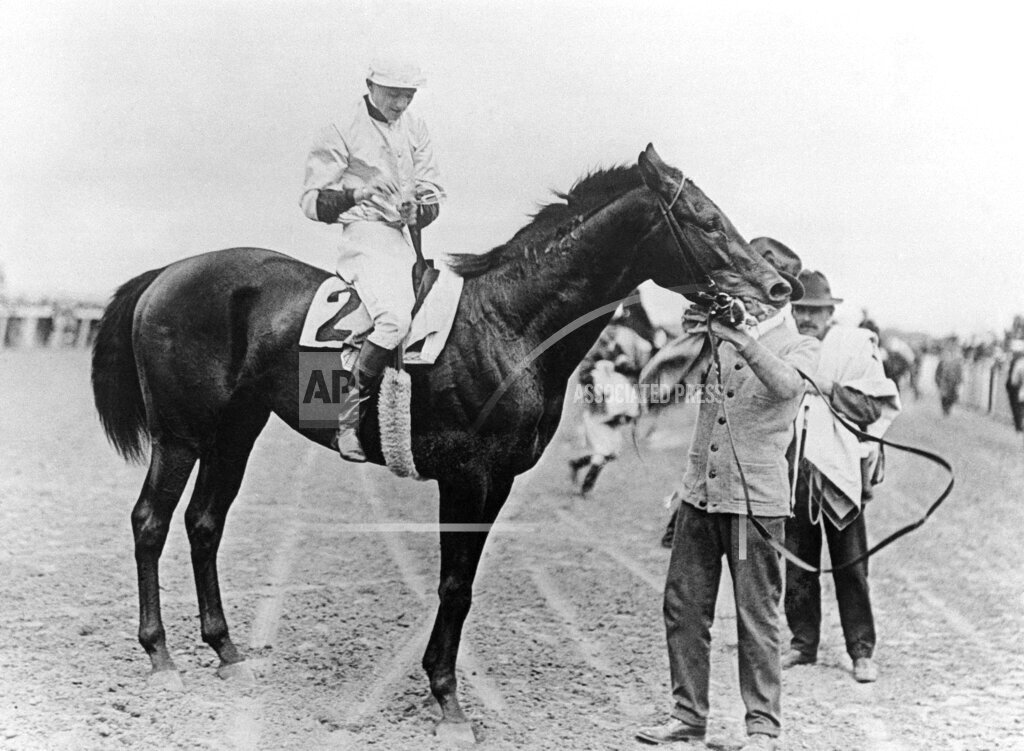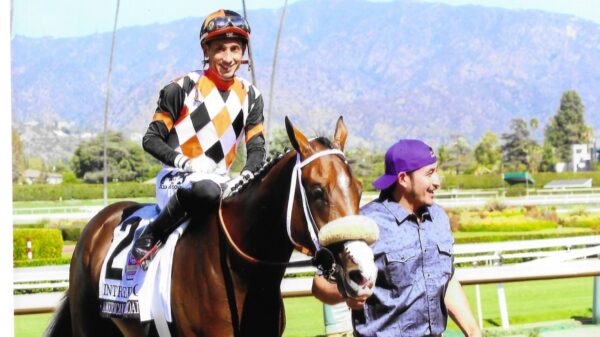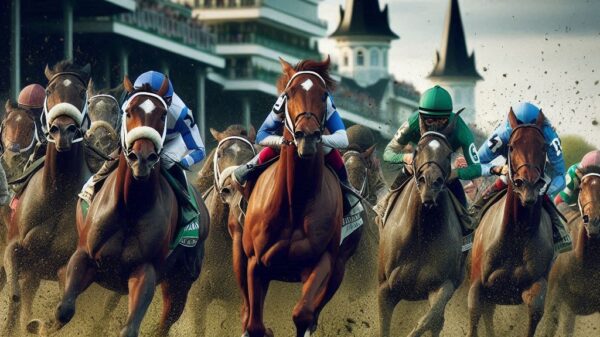
Rinaldo Del Gallo, III
By: Rinaldo Del Gallo, III
One-hundred years ago, ZEV (USA) br. H, 1920 {23-b} was to win the Kentucky Derby. It was a tad bit of a strange journey by today’s standards. You see, when Zev won the Kentucky Derby on May 19, 1923, he had already lost the Preakness.
On May 12, 1923, held only one week earlier, Zev lost the Preakness. He had come in 12th place, 26 ¼ lengths back, and I kind of question whether they really got that extra ¼ length part right, but so the DRF records read. The Preakness was won by VIGIL (USA) ch. H, 1920 {27-a}, a tail male descendant of Bend Or through his son GOLDEN GARTER (GB) ch. H, 1888 {2-g}. Vigil was to take third in the Kentucky Derby.
On top of being one week earlier, the Preakness was at 1 1/8th miles, not its traditional 1 3/16 miles. When Vigil won the 1923 Preakness, it was the second to last time it would not be run of today’s traditional distance of a 1 3/16 miles. The Preakness had a 13 year stint at 9 furlongs, the last being when the filly and 3 year old champ NELLIE MORSE (USA) b. M, 1921 {9-f} the year after Vigil. It even had a stint in the state of New York, but we will leave that for another day. It was not the only time the Preakness was before the Kentucky Derby, as the Kentucky Derby winner Gallant Fox won the Preakness on Friday, May 9, 1930, and then won the Saturday, Kentucky Derby on May 17, 1920, 8 days later.
Pictured below: Zev

The almost Triple Crown winner, TWENTY GRAND (USA) b. H, 1928 {5-g}, also ran in the Preakness first, the Kentucky Derby second and the Belmont third. It was apparently a controversial Preakness as DRF has the notes “impeded” and pedigreequery.com states that Mate “should have been disqualified.” But for that second-place finish in the Preakness back 1 ½ lengths, Twenty Grand would have been the third Triple Crown winner.
But back to Zev and his campaign 100 years ago. When you think of one week between the Preakness and the Belmont, the modern reader will think, “Wow, that’s insanely quick.” But the connections of Zev thought, “Hey, let’s get another race in between.” After running the $62,000 Preakness on Saturday, May 12, 1923, at Pimlico, the connections of Zev had him run in the $4,100 6-furlong Rainbow Stakes at the Jamaican Race Track in New York—I assume that all shipping was by rail, but this is only a guess on my part. Zev won the Rainbow Stakes by a ½ length on Tuesday, May 15, 1923. They then sent Zev out to Churchill Downs, and on Saturday, May 19, 1923, Zev won the $63,000 “Run for the Roses,” with Vigil in 3rd. That’s right, Zev had run 3 races in a week’s time, two of them American Classics.
At that time, one would think a thoroughly exhausted Zev would get a good rest before the 55th Belmont Stakes at Belmont Park, to be held on Saturday, June 9, 1923, for a $46,000 purse. There were 35 days between the Kentucky Derby and the Belmont, plenty of time to rest up—but of course, that didn’t happen. Horses were run much more often in the past. After winning the Kentucky Derby on Saturday, May 19, 1923, Zev was sent to run in the 1-mile Withers, then a very prestigious race, with a purse of $20,000 to be held at Belmont Park, to be held one week after the Kentucky Derby on Saturday, May 26, 1923.
Zev won by ½ length over MARTINGALE (USA) b. H, 1920 {A1}, a horse that Zev had beat by 1 ½ lengths in the Kentucky Derby a week prior. Martingale had descended from the MARTAGON (GB) b. H, 1887 {16-g} branch of Bend Or. Other horses to have run in the Withers between the Preakness and Belmont include SIR BARTON (USA) ch. H, 1916 {9-g}. Whirlaway won an allowance between the Preakness and Belmont on May 20, 1941, at Belmont—I have no idea what the conditions were, Whirlaway was doing well that year, so maybe it was non-winners of the last five minutes.
The Belmont was raced on Saturday June 9, 1923, two weeks after the May 26th Withers, and at least Zev did not have to ship again. It is to be remembered that by American standards, the Withers was an old race, and that the winner of the second running of the Withers, was the horse that won the first running of the Kentucky Derby, ARISTIDES (USA) ch. H, 1872 {A9}. In 1923, the Belmont was run at 1 3/8 mile, not 1 ½ miles as it is today. Zev won by 1 ½ lengths. The reader might think it quite natural for a horse to run in all three classic races, but the British born WAR CLOUD (GB) b. H, 1915 {4-l}, born a mere five years before Zev, was the first horse to run in all three classics. Zev paid $19.20 on a $2 bet to win the Kentucky Derby. By his Belmont win, he paid 80¢ on a $2 bet.
After his Belmont win, Zev ran in 8.6 K Queens County Handicap at Aqueduct, a race first run in 1902 and still run to this day. DUNLIN (USA) ch. H, 1920 {10-c} (a product of the highly successful mating of Fair Play with Rock Sand dams) came in second. I don’t know what happened, but Zev then had a real break, and took the summer off and had a 70-day rest before a start in a $1,238 allowance race at Belmont Park. It must have been another you have-not-won-in-the-last-five-minutes allowance race.
I have no idea why Zev didn’t go to Saratoga to run in the Travers stakes. Get this—Zev ran seven times—yes, seven times—at Saratoga racecourse in the month of August of 1922 when he was two years old. In 1922, on August 1st Zev lost a maiden special weight, on August 5th he won a maiden special weight, on August 8th he won an allowance, on August 15th he won an allowance, on August 19th he won the 12K Grand Union Hotel Stakes beating DUNLIN (USA) ch. H, 1920 {10-c}, on August 28 he won the 4.9 K Albany Handicap, and on August 31st he came in 3rd to Dunlin in the $43K Hopeful.
Zev was second to SALLY’S ALLEY (USA) b. M, 1920 {A1} in the $55k Belmont Futurity. Despite these losses, and six straight losses to start off his career, Zev was declared two-year old champion. (Sally’s Alley was declared two-year-old champion filly.) Zev did well at Saratoga, and one would have thought he had a real shot in the Travers (which is run there), but he was not to run it. WILDERNESS (USA) ch. H, 1920 {A4} was to win the Travers stakes that Zev did not participate in—Wilderness was third in the Belmont Futurity. After Zev’s two-year-old campaign, he never went back to The Spa.
August of his two-year-old campaign at Saratoga was not the only time Zev was to run an incredible number of races—from September 1, 1924, until November 8, 1924, a period of 68 days, Zev ran 12 times. That’s an average of 5 2/3 days between races—12 times. In one of those races, in an $1800 handicap held on October 18, 1924, at Latonia Racetrack, Zev beat PRINCESS DOREEN (USA) b. M, 1921 {9-g}, who also made it to the Hall of Fame. In the $4.5K 6-furlong Arverne Handicap held at Aqueduct on September 24, 1924, Zev lost by a nose to the Hall of Fame gelding SARAZEN (USA) ch. G, 1921 {20}. Obviously, being a gelding, Sarazen is not in the breed but his full brother MIRAFEL (USA) b. H, 1924 {20} made it into the breed through the descendants of EVENING SUN (USA) b. M, 1955 {8-d}.
After a 70-day rest between when he started and won the $1,238 allowance race at Belmont Park, Zev took the prestigious Lawrence Realization Stakes at Belmont for a $28K purse. The Lawrence Realization Stakes was run from 1909 to 2005. When Zev won it, it was 13 furlongs at Belmont. He beat the filly UNTIDY (USA) b. M, 1920 {5-i}, the three-year-old champion filly that won the Kentucky Oaks, the Alabama, and the Gazelle. RIALTO (USA) b. H, 1920 {4-m}, who had been 3rd in the Preakness and the Belmont, was also third in the Lawrence Realization.
After the Lawrence Realization, Zev was entered in a phenomenal match race, one of the greatest of all time. A silent film was made of it and shown at theaters everywhere. This film is available on Youtube. The Kentucky Derby winner Zev was to race against the Epsom Derby winner, PAPYRUS (GB) br. H, 1920 {16-f}, who was also second in the St. Leger. Of note, second in that Epsom Derby was PHAROS (GB) br. H, 1920 {13-e}, an incredibly important sire who sire many excellent horses including Nearco. The horse that came in 3rd in that 1923 Epsom Derby was PARTH (GB) b. H, 1920 {22-d}, and Parth won that year’s Prix de l’Arc de Triomphe, the fourth running of that rich race.
This match race was called the “International Race” and was to be run at Belmont Park. The money was absolutely insane—the purse was for $105,000. It was the richest race in the world at that point. Despite the extreme build up, unfortunately, the race was not that close with Zev winning by 5 lengths in the mile 1 ½ lengths over a sloppy course. Of course, Papyrus had to be shipped and was running on dirt. (A newspaper account called it 4 lengths.)
That $100,000 purse of October 23, 1923, may have been the first time $100,000 was put down for a purse, that sum of money being the moniker for the Santa Anita Derby in future years. The 1929 Belmont Futurity would have a purse of $105,730 (DRF has $109,000) which was won by WHICHONE (USA) br. H, 1927 {2-d}, the horse that was to breakdown and come in third and last to Jim Dandy and Gallant Fox in the 1930 Travers—Gallant Fox came in 3rd in that super rich Belmont Futurity.
A 22 silent film documentary was made that can be watched here of Zev v. Papyrus:
As was noted in the excellent story, “History in the Making: The Zev-Papyrus Match Race,” “The winner’s share of the massive purse propelled his lifetime earnings to $254,908, surpassing the record set by the immortal Man o’ War.
Papyrus had two handicaps. (1) He had shipped from overseas, and (2) the race was run on dirt, and horses from Europe run on the grass.
In November 17, 1923 Zev had match race with IN MEMORIAM (USA) b. H, 1920 {4-b}, a horse that won the Latonia Championship with its rich purse of $65,000 dollars. In Memoriam was one of the last horses of the Rataplan sire line. In Memoriam won by 6 lengths in that Latonia Championship, which ended Zev’s nine race win streak. A $2 bet was going to pay 40¢ on Zev in that rich race. The horse that came in 3rd in that rich Latonia Championship, MY OWN (USA) b. H, 1920 {25}, had previously 6 straight wins to start his three-year old campaign.
When Zev looked a little lame before the match race with Papyrus, My Own was regarded as a possible substitute for the American side. “This was due to Zev not working well on Wednesday morning, and developing blotches, which, it was thought, might be hives.”
A match race was set up between Zev and In Memoriam, at Churchill Downs for $30k, to take place on November 17, 1923. The race was for 1 ¼ miles, the same distance and track as the Kentucky Derby. Zev won by a nose. Wikipedia says it was “controversially close.” According to one source, an eBay sale of the match race program, “Zev was declared the winner by inches, but later motion pictures showed In Memoriam actually won. There was no way to reverse the outcome since the photo finish camera had not been developed.”
Zev v. In Memoriam
This is the better-you be the judge. Who won the match race? Zev. or In Memoriam? Zev is Number 2 in the blinkers, on the outside as they go into the home stretch.
Zev’s penultimate race was also a weird one. It was Zev’s 43rd start. It was a 6-furlong race for 2,000 dollars. He seems to have taken the lead in the stretch. But Zev lost. And this was what was remarkable about the loss. Zev lost that Friday, November 7, 1924, handicap race by a mere neck—he came in 4th place nonetheless.
Not many horses are a neck behind the winner and come in 4th place: quite a blanket finish. The horse that won that penultimate allowance was named Swinging according to the DRF records. I can’t see the program (and thus able to pick up on the horse’s pedigree), but I presume that was the filly SWINGING (USA) ch. M, 1922 {5-j} . Swinging was “Ms. Second” in stakes races, with a second in the Endurance H., Demoiselle S., Matron S., Rosedale S., Clover S. and 3rd in the Astoria Stakes. Swinging was destined to be the dam of 1932 & 1933 Horse of The Year and 1957 Hall of Fame inductee Equipoise.
IN THE STUD – Zev’s Pedigree was magnificent.
What is interesting is that Zed was somewhat of a failure at stud despite looking so excellent on paper. He sired a minor stakes winner ZEVSON (USA) b. H, 1932 {3-k}, who did himself sire an okay runner TEEGEE (USA) H, 1945 {22-d} from a mating with a Dunlin mare, the horse that raced against Zev. There was a dam, A GLEAMING BEAM (USA) ch. M, 1979 {5-g}, with Zev’s blood, that was a producer of many winners. There was a horse, SOUTH EAST DANCE M, 2008 {5-g}, who had some of Zev’s blood, but for the most part, Zev is not in the modern thoroughbred. It would not surprise me if there were literally zero modern thoroughbreds registered with his blood, but someone can have some fun and prove me wrong.
It was a somewhat surprising outcome that Zev proved far less than stellar in the stud. Zev’s sire, THE FINN (USA) blk. H, 1912 {4}, was a monster of a racehorse and won the Belmont and Withers just like Zev. (The Finn’s sire, the British born but American raced OGDEN (GB) b. H, 1894 {6-e} was second in the Withers. Ogden also won the rich Belmont Futurity in 1896—that would be a race where Zev came in second in 1922.) The Finn won so many races, and races of such quality, it would not seem out of place to see him in the Hall of Fame.
The Finn sired the excellent runner KAI-SANG (USA) br. H, 1919 {9-c}, and he took many races and took second in the Travers (for which Zev was never entered.) Kai-Sang ended up in the blood of DANCER’S IMAGE (USA) gr. H, 1965 {4-r}, who ended up being the sire of the second dam of DANEHILL DANCER (IRE) b. H, 1993 {22-b}, so Kai-Sang stayed in the breed. Kai-Sang is also in NORTHFIELDS (USA) ch. H, 1968 {4-r} and HABITAT (USA) b. H, 1966 {4-r}.
Zev’s son FLYING EBONY (USA) blk. H, 1922 {5-i} won the Kentucky Derby, the race Zev completely flubbed. Flying Ebony was the sire of DARK SECRET (USA) b. H, 1929 {2-h}, a horse that had a tragic ending while winning the 2-mile Jockey Gold Cup. One of Flying Ebony’s other excellent runners was FLYING HEELS (USA) br. H, 1927 {A4}, who himself sired a Kentucky Oaks winner FLYING LILL (USA) br. M, 1936 {2-a}. So, it wasn’t as if Zev did not have a solid foundation in his sire The Finn.
ZEV (USA) br. H, 1920 {23-b} was also from a very respectable and highly productive female family. It was a bit of an unusual female family. You see, most of the St. Simon sire line that was great in America were from horses that had at least 3 generations of St. Simon in Europe before coming over seas to the states—commentators at the time believed that St. Simon’s first generation progeny were not the best of sires and that the best St. Simon sire line horses were from branches that spent the first generation after St. Simon in Europe. Remarkable for an American horse born in 1920, Zev’s dam, second dam, and third dam were from horses that were sired by a son of St. Simon. There was more St. Simon in Zev then Papyrus, and Zev came from an old American female family and Papyrus was thoroughly English, from the Rock Sand sire line. It was a tad-bit strange.
As for St. Simon’s first dam, Miss Kearney, her sire, the winner PLANUDES (GB) b. H, 1897 {21-a} sired a number of good stakes runners such as WALDO (USA) b. H, 1907 {12-b}, a co-champion two year old, or MEELICK (USA) ch. H, 1905 {13-c}. But he was hardly the magnificent sire as compared to St. Simon’s sons back home. Zev’s dam MISS KEARNEY (USA) b. M, 1906 {23-b} won the 5-furlong Dash Stakes at Sheepshead Bay at age 2, a race of some note at the time, and was second in the Alabama at age 3 to Hall of Famer MASKETTE (USA) br. M, 1906 {8-h}.
Apart from Zev, Miss Kearney had 3 other stakes winners: TRIPLE CROWN (USA) br. M, 1914 {23-b}(Bouquet Selling Stakes); NEDDAM (USA) b. H, 1917 {23-b}(Babylon Handicap, placed in other stakes); WAR MASK (USA) b. G, 1916 {23-b} (won Gretna Handicap and placed in many other stakes). War Mask had run against the likes of Hall of Fame horses BILLY KELLY (USA) b. G, 1916 {9-c} and TIPPITY WITCHET (USA) b. G, 1915 {31}. So, Zev’s mother Miss Kearney was both a stakes winner, placed second in the Alabama, and was quite a producer.
Zev’s second dam is even more enigmatic– COURTPLASTER (USA) br. M, 1902 {23-b} was also a producer. Her get included the Yankee sired gelding PENOBSCOT (USA) ch. G, 1909 {23-b}(American Grand National Steeplechase, Independence Steeplechase Handicap, and a filly named STICKER (USA) b. M, 1907 {23-b}(Bellerose Stakes at Aqueduct against the boys, took second in the prestigious Great Filly Stakes, and was third in the Spinaway Stakes).
Of note, Courtplaster had an unraced daughter THE NURSE (USA) b. M, 1911 {23-b}, who interestingly had two daughters named after famous nurses, FLORENCE NIGHTINGALE (USA) br. M, 1922 {23-b}(Coaching Club Oaks, named after person who founded the Red Cross) and EDITH CAVELL (USA) b. M, 1923 {23-b}(also won the Coaching Club Oaks like her sister, and also won and placed in many other stakes races. Edith Cavell was a famous nurse of World War I fame.)
The Nurse was also the dam of stakes winners NORMAL (USA) b. H, 1918 {23-b}, and YOUNEED (USA) b. H, 1916 {23-b}(Union Claiming Stakes, placed in several other stakes.} Of interest, Youneed beat Ms. Kearney’s son War Mask in that Union Claiming Stakes. Youneed had Ogden as a sire, Zev’s second sire. I leave it for the reader to decide how YOUNEED (USA) b. H, 1916 {23-b} and WAR MASK (USA) b. G, 1916 are related, and how Zev and YOUNEED (USA) b. H, 1916 {23-b} are related—Zev and War Mask share common sire and female lines. Anyhow, you can see that Zev’s dam and second dam were producers. Decedents include Louisiana Derby winner BOVARD (USA) dkb/br. H, 1945 {23-b}. Zev’s fifth dam, MANNIE GRAY (USA) blk. M, 1874 {23-b}, was a dam of great renown then and today.
Going back to Zev’s second dam COURTPLASTER (USA) br. M, 1902 {23-b}, she was 2s x 3d St. Simon. Courtplaster’s sire was SANDRINGHAM (GB) br. H, 1896 {7-f}, named after the castle in England. Sandringham was unraced. Sandringham did sire the Preakness winner ROYAL TOURIST (USA) b. H, 1905 {A5}, which was a clever mixture of the sire’s name and the dam ROYAL TOURIST (USA) b. H, 1905 {A5}. (Leisure was the dam of another Preakness winner, Holiday).
Sandringham’s son SAND MARSH (USA) b. H, 1912 {26} was to win the 1916 PAUMONOK STAKES at the Jamaican Race Track, a race Zev won in 1923. Sandrigham’s brothers were brilliant sires DIAMOND JUBILEE (GB) b. H, 1897 {7-f}, PERSIMMON (GB) blk/br. H, 1893 {7-f}(from whom Princequillo descended), and FLORIZEL (GB) br. H, 1891 {7-f}(who oddly died while being exercised at Sandrigham.) Sandrigham even had a son, GOOD LUCK (USA) b. H, 1903 {22-c}, who won the California Derby. Sandrigham son DELIRIUM (USA) b. G, 1905 {5-g} won the Manhattan.
Zev’s third dam, SET FAST (CAN) ch. M, 1894 {23-b}, appears to have been bred in Canada. She was second in the 1897 Get Away Stakes at Saratoga and was third in the inaugural running of the 7-furlong Van Cortlandt Handicap (also 1897) that ran at Morris Park and then Belmont Park, from 1897 to 1910. Set Fast’s sire was MASETTO (GB) br. H, 1888 {9-a}, yet another son of St. Simon. Masetto was a useful sire, siring horses such as THE MUSKETEER (USA) b. H, 1898 {2-a}(Test Handicap), THOMAS CAT (USA) b. H, 1894 {5-h}(won or placed in a number of stakes)—Thomas Cat was second in the Turf Handicap at Sheepshead Bay, believed to be the first turf stakes race in the country.
As stated, Zev was 3d x 4d x 5d St. Simon, as his dam, second dam, and third dam were sired by son of St. Simon. His fourth dam, BANDALA (USA) ch. M, 1883 {23-b}, won the prestigious Ladies Stakes and Mermaid Stakes at age 3. Bandala was sired by King Ban, found in many pedigrees today through his daughters.
Yet despite this excellent pedigree, Zev was largely unsuccessful at stud.
Papyrus’ at Stud
By contrast, PAPYRUS (GB) br. H, 1920 {16-f} was sent back to England where he stood at stud. He was an okay, but hardly brilliant sire. Wikipedia states, “He sired some good winners but was not a great success.” A gelding son of Papyrus named PAPERBOY (GB) b. G, 1938 {5-i} ran in the states and he won some big stakes races.
But Papyrus was to make his mark on the thoroughbred. His son OSIRIS (GB) ch. H, 1926 {2-t} became a leading sire in Canada in 1938, 1940, 1942, 1947. His Breeder’s Sakes winning daughter MONA BELL (CAN) ch. M, 1935 {10-c} died at age four, but her full sister IRIBELLE (CAN) b. M, 1942 {10-c} became the foundation mare of Foundation mare for Windfields Farm. VICTORIA PARK (CAN) b. H, 1957 {10-c}, who’s second dam is Iribelle, was the damsire of the superb runner and excellent sire THE MINSTREL (CAN) ch. H, 1974 {8-f} and his full brother FAR NORTH (CAN) b. H, 1973 {8-f}. Victoria Park was the damsire of 11-time leading Japanese sire NORTHERN TASTE (CAN) ch. H, 1971 {14-c}.
Also, Victoria Park’s dam, VICTORIANA (CAN) b. M, 1952 {10-c}, was the second dam of the incredible sire VICE REGENT (CAN) ch. H, 1967 {10-c} and his full brother VICEREGAL (CAN) ch. H, 1966 {10-c}(the excellent sire). From Vice Regent you get many excellent horses and sires, including DEPUTY MINISTER (CAN) b. H, 1979 {10-a}, who sired AWESOME AGAIN (CAN) b. H, 1994 {1-c}. From Iribelle herself, Papyrus would have a big mark on the breed, but she was not remotely the only source of Papyrus.
Papyrus sired the French stakes winning filly COSQUILLA (GB) b. M, 1933 {1-b}, who became the dam of the highly influential PRINCEQUILLO (GB) b. H, 1940 {1-b}, found in a strong sire line but more importantly in the blood of SEATTLE SLEW (USA) dkb/br. H, 1974 {13-c} and SECRETARIAT (USA) ch. H, 1970 {2-s}.
Papyrus was even the sire of BARBARA BURRINI (GB) b. M, 1937 {4-l}, who was the second dam of RIBOT (GB) b. H, 1952 {4-l}. (Ribot is the sire of the important sire HIS MAJESTY (USA) b. H, 1968 {4-d}, His Majesty being the dame sire of the important sire Danehill and Dynaformer.) STAR KINGDOM (IRE) ch. H, 1946 {1-g}, who was champion sire in Australia five times, had Papyrus in his pedigree, Papyrus being the sire of Star Kingdom’s second dam THOUGHTLESS (GB) br. M, 1934 {1-g}.
MISWAKI (USA) ch. H, 1978 {16-g}, is the sire of the Arc winning filly URBAN SEA (USA) ch. M, 1989 {9-h}. Urban Sea, is in turn the sire of the super sire GALILEO (IRE) b. H, 1998 {9-h} and SEA THE STARS (IRE) b. H, 2006 {9-h}. Miswaki’s second dam is Matron Stakes winner ROSE BOWER (USA) ch. M, 1958 {16-g}, who was sired by Princequillo. If you were to look at PULPIT’s (USA) b. H, 1994 {2-f} pedigree, between Seattle Slew, Secretariat, Sir Gaylord, and the mare MONARCHY (USA) b. M, 1957 {2-f}, I can identify four appearances of Princequillo.
Turning to Tapit, FAPPIANO (USA) b. H, 1977 {16-a} has a third dam from Princequillo, CEQUILLO (USA) b. M, 1956 {16-a}. Descendants of Cequeillo include OGYGIAN (USA) b. H, 1983 {16-a}, HONOUR AND GLORY (USA) dkb/br. H, 1993 {16-a}, QUIET AMERICAN (USA) b. H, 1986 {16-a}(4s x 3d Cequillo). BOLD BIDDER (USA) b. H, 1962 {3-n} has a third dam sired by Princequillo, STEPPING STONE (USA) b. M, 1950 {3-n}. Through Princequillo’s daughter MONARCHY (USA) b. M, 1957 {2-f}, descend in tail female, JOHANNESBURG (USA) b. H, 1999 {2-f}(sire of Scat Daddy), TALE OF THE CAT (USA) b. H, 1994 {2-f}, FED BIZ (USA) b. H, 2009 {2-f}, PULPIT (USA) b. H, 1994 {2-f}, and KEY BRIDGE (USA) b. M, 1959 {2-n}, dam of Key to the Mint, Key to Content, Fort Marcy & Key to the Kingdom, is a daughter of Princequillo.
If you look at Tapit’s son FLIGHTLINE (USA) b. H, 2018 {20-b}, his dam FEATHERED (USA) dkb/br. M, 2012 {20-b} has multiple branches to Princequillo) through Ribot, Storm Cat/Secretariat, and DIPLOMAT WAY (USA) b. H, 1964 {22-c} who’s damsire is Princequillo.
Between Princequillo, (found in Seattle Slew, Secretariat, Sir Gaylord, Sham, Galileo, Sea the Stars, One for All, Ack Ack, Diplomat Way, Fappiano, Ogygian, Pulpit, Johannesburg, Key to the Mint, Gilded Time, & Mill Reef), The Minstrel, Vice Regal, Vice Regent (Deputy Minister, Awesome Again, and many others), Far North, Northern Taste, Star Kingdom, Riverman, Cozzene, and Ribot (Danehill, Pleasant Colony, Alleged [Dr. Devious’ dam sire], Hoist the Flag [sire of Machiavellian’s second dam], Dynaformer and others), there are few horses on any given card that lack Papyrus blood anywhere in the world, especially in North America.
You have to go back to the 1980’s to find horses free of Papyrus blood winning major stakes races. It is hard to find a horse that won or placed in the Arc without Papyrus blood—I thought I had one in EGYPTBAND (USA) b. M, 1997 {2-h} who came in second in 2000, but her eight dam is MARSH MAIDEN (GB) ch. M, 1926 {2-h}, sired by Papyrus.
While almost all thoroughbreds of any consequence born after 2000 have the blood of Papyrus, on the other hand, none have the blood of Zev. It is almost 100% versus 0%. Papyrus won the breeding match race, and he did it by a lot.







